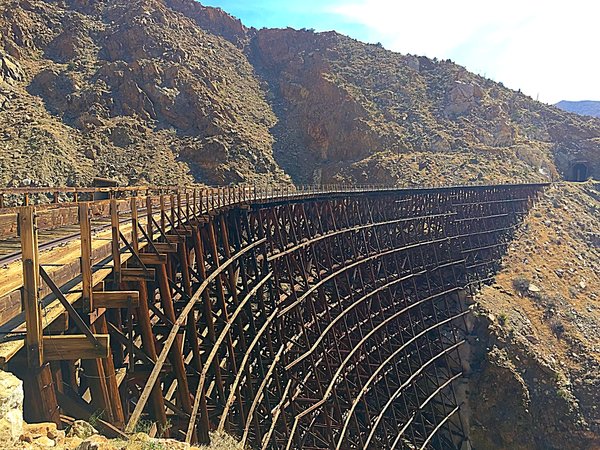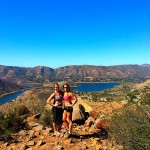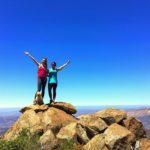Let me preface this post by explicitly stating that the El Cajon Mountain Trail is an extremely difficult trail. The trek to the summit gains around 3,200 feet in elevation and the hike back out picks up another 800 feet of elevation gain. This isn’t being said to scare off novice hikers, it truly is strenuous even for the most seasoned hiker. In fact, when I recently hiked this trail in early June I wasn’t prepared for what I was getting into. About 9 miles into my trek, I ran out of my 2-liter water supply completely on a day with 90-degree heat. I had to track down another hiker who had brought a sufficient amount of water to ensure I didn’t die of heat exhaustion. That’s how serious this trail is.

Strong warnings aside, El Cajon Mountain is a trail that makes you a strong sense of accomplishment once it’s completed. There will be plenty of sweat and undoubtedly moments where you feel like you can’t continue any further, but the reward of finishing a hike that is both mentally and physically challenging makes the trek worthwhile. This hike can also serve as a great form of training for tackling harder California trails such as Half Dome at Yosemite National Park or Mount Whitney in Sequoia National Park.

The trail for El Cajon Mountain picks up in the dirt parking lot. Please note this lot does not open until 7am, but most people will want to get started on this hike before then to avoid peak sun exposure. If you will be starting this hike prior to 7am, park on the side of Wildcat Canyon Road on the shoulder. From the parking lot you will begin your initial ascent up a paved road that takes you past a few homes and the Blue Sky Ranch. As you pass the Blue Sky Ranch, the road will bend to yet another trailhead which is the official starting point to this hike. Here you’ll find the only restrooms on the trail as well as a garbage can.


Follow the fire road uphill to begin your first series of switchbacks. You will soon pass by your first mile marker, the first in a series you will see as you continue up to the El Cajon Mountain Summit. These markers are useful in tracking your distance, keeping track of the elevation changes, and seeing a preview of what is to come for each mile of the trail. The first mile is somewhat strenuous, but is just a preview of what is to come.

At mile 2 your legs will get a welcome break as you have a short descent and then will trek along a relatively flat portion of the trail. Enjoy this break because at mile 3, the real journey begins.
At mile 3 you’ll find a structure that provides shade. This is a good place to take a break and let your heart rate drop as there are no other structures that provide shade for the remainder of your ascent to the summit. Instead you’ll have to find boulders to seek reprieve from the sun under for the remaining stretch. Mile 3 is also where the most strenuous portions of the trail begin. The next mile will be mostly uphill with plenty of elevation gain.

Bench at mile 3
Miles 4-5 will consist of uphill climbs as well, but the real challenge is the last mile. You’ll know it’s almost time for the last mile when you pass a rusted truck on your right. This marks the onset of the hardest portion of the trail.


The final push to the summit is perhaps the most treacherous part of the trail. The trail narrows, is harder to follow, and requires rock scrambling in some parts. When you reach the top of the boulders, your quads can take a breather as the trail levels out. Continue along the trail until you reach the green marker indicating you’ve reached the El Cajon Mountain summit.




From the summit take in the views of the Cuyamaca Mountains in the west, the Pine Creek Wilderness peaks to the south, and the Palomar Range to the north. Once you’ve had your fill of the panoramic views that surround you, re-trace your steps back to the trailhead. Keep in mind that your legs at this point will be sore and you will still need to tackle 800 feet of elevation gain. On your descent: maintain your balance, take breaks when needed, refuel your body, and stay hydrated.

El Cajon Mountain Tips
Tip #1: This hike is long and strenuous. You will need at least 3 liters of water, possibly more on a summer day.
Tip #2: That being said, because of the difficulty this hike it should not be attempted during summer. Instead save this hike for colder months.
Tip #3: This hike is not suitable for pets or children.
Tip #4: Trekking poles are beneficial for this hike due to several steep sections.
Tip #5: Bring plenty of protein-packed snacks/meals. You will need plenty of energy to complete this trail.
Tip #6: Bring a cell phone in case of an emergency. Cell reception is available during the majority of this hike.
Tip #7: This hike is not for beginner or intermeddiate hikers. This should only be attempted by experienced hikers who have experience with long-distance hiking, steep inclines, or cross-train at a gym.
Driving Directions
From downtown San Diego: Take I-163N and merge onto I-8E until you reach Highway 67. Exit at Willow Road. Take a right onto Willow Road and follow it until you reach Wildcat Canyon Road (after you pass the rodeo grounds). Turn left onto Wildcat Canyon Road and follow it for 3.3 miles. Turn right and park in the dirt lot to your left. The Oak Oasis Open Space Preserve is directly across the street for reference.
Elevation Gain: 4,000 feet
Time to Complete: 6-7 hours
Difficulty: Strenuous
Total Distance: 12 miles
Trailhead Address: Directly across from 12620 Wildcat Canyon Road, Lakeside, CA 92040



 Bernardo Mountain Summit Trail | Escondido, CA
Bernardo Mountain Summit Trail | Escondido, CA


